Being a sustainable medium duration cash crop with high return in irrigated lands, the Banana is widely been cultivated by the small and marginal landholders. Of late, there has been a noticeable increase in the area under G-9 banana in Uttar Pradesh and Bihar. G-9 is the only variety that is being cultivated in the sub-tropical conditions. In June 2017, there was a sudden epidemic of the Fusarium wilt disease in the Sohawal block of Faizabad District. The disease caused by Fusarium oxysporum f.sp. cubense is a devastating disease of banana and particularly Tropical Race 4 (TR4) affects the Grand Naine (G-9) banana variety. The disease caused huge loss to the growers and spread rapidly in soil and water.
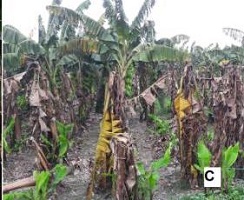
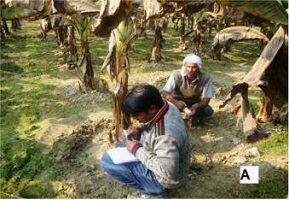
The villages - Katrauli, Magalsi and Muksoonganj of Ayodhya District witnessed severe incidence of the disease with about 30 to 45 percent mortality of bearing plants. About 95 % of the areas (more than 140 acres) under the banana in these villages were found to be affected with the disease that resulted in loss of more than 50% of the total investments. The intensive survey conducted in the states of Bihar and Uttar Pradesh revealed huge damage caused by the disease in many banana growing Districts of Uttar Pradesh namely Maharajganj, Sant Kabir Nagar, Kushinagar, and Sitapur.
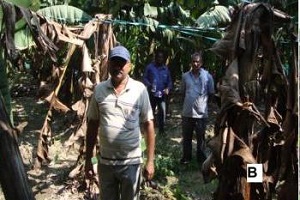
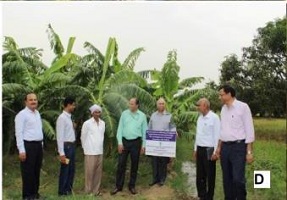
In Bihar, in the Districts - Katihar, Purunia, Baghalpur, Vaishali and Naugauchia Districts, the farmers experienced the losses of worth millions of rupees. These Districts were once well-known for the commercial production of G-9 Banana. The farmers went after all the available options of fungicides and bio-products available in the market and tried their every level best to overcome the disease.
But, all the efforts failed in yielding the successful results ending in the loss of crop by more than 50%. This compelled them in switching-over to the other alternative cropping system as input cost in banana is too high. The economic losses caused by the disease alarmed not only the farmers, but the government officials and scientists from other parts of the country too.
It was at this juncture, that the scientists of ICAR-Central Soil Salinity Research Institute (CSSRI), RRS, Lucknow and ICAR-Central Institute of Sub-tropical Horticulture (CISH) confirmed the presence of the disease through the morphological and molecular techniques.
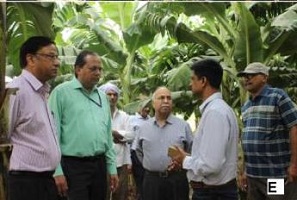
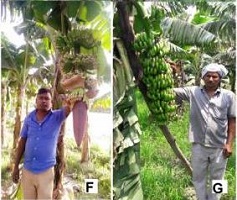
Based upon the positive results obtained in the laboratory and pot experimental studies, the scientists came up with a bio-formulation using the eco-friendly effective antagonistic microbes on a unique IPR protected bio-media with the defined protocol of application. The technology was immediately intervened in all the three affected villages of Uttar Pradesh. The farmers were made to adopt the new bio-formulation application protocol along with other precautionary measures to reduce the incidence of the disease through the community field sanitation and participatory technology adoption approach. The adopted fields witnessed 5 to 10% incidence of the disease while the adjacent non-adopters faced rapid disease proliferation destroying more than 40% of the crop that compelled them to remove the crop.
Coming to know about the spreading of disease in his field, Shri Anand Kumar Apte, a progressive farmer of the Katrauli village decided to leave the banana plantation. But, with the help of ICAR-CSSRI and ICAR-CISH scientists, he adopted the management technology and has now, successfully harvested a bumper crop with an income of Rs. 1.50 lakh from his one acre land.
Simalarly, Shri Shalikram, a banana grower of the Magalsi District was the first person in the village, whose plantations was affected since four years. Due to unawareness, he continuously lost four crops of banana due to the disease. Upon obtaining the awareness and adoption of ICAR-FUSICONT technology, he could now, survive his 90% of the banana plants planted in the same fields.
The technology proved to be a real helping hand for many other farmers namely - Shri Ganesh Verma (Mukssonganj), Shri Ramesh (Magalsi), Shri Shoba Ram (Magalsi), etc., who had been successful in controlling about 90% spread of the disease with the help of the technology.
Based on these results the scientist team moved to work on more severely affected Katihar districts of Bihar with the objective of replicating the positive results of Sohawal.
As a pilot demonstration, the product was tested in the Katihar District on over 60 acres of bananas. More than 30 farmers came to adopt the technology with the hope to restore the banana cultivation in the most severely affected area. The formulation was made available to the farmers of Katihar District from Lucknow through public transport services from time-to-time and disease spread was constantly monitored. The farmers were guided as per the requirements. Ten months after the intervention of the technology, drastic reduction in the disease to the level of 95% was witnessed in the survey. The farmers, who adopted the technology, were overwhelmed by the response of the formulation.
Shri Amarnath Jha, a progressive farmer of Dighri village of Katihar District in Bihar shared his views that after adopting the technology, he did not found a single diseased plant in his 5 acres plantation after using the formulation in his orchard. He mentioned that the plantation was initially showing more than 30% of the disease inocula prior to the use of technology.
Shri Naveen from Kursela also confirmed the significant recovery of the plants due to the application of ICAR-FUSICONT, which were initially affected with the panama wilt disease.
The technology has proved to be a real helping hand for the farmers as it is capable to bring back the banana cultivation of the region through the community efforts.
(Source: ICAR-Central Institute of Subtropical Horticulture, Lucknow)








Like on Facebook
Subscribe on Youtube
Follow on X X
Like on instagram